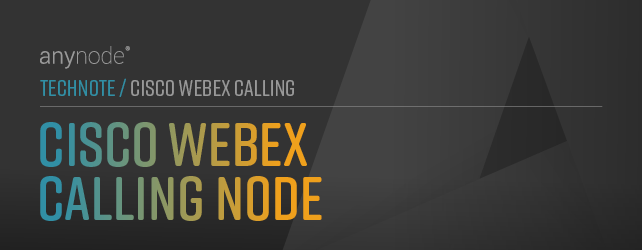
Cisco Webex Calling Node
Video: Node Configuration for Cisco Webex Calling with anynode – The Software SBC.
In this chapter, we'll delve into the essential aspects of configuring the Cisco Webex Calling node. By understanding and implementing the concepts and configurations outlined in this chapter, users will be well-equipped to establish and optimize their Cisco Webex Calling node, ensuring smooth and secure communication with the cloud-based calling service.
A brief overview of the key topics covered:
-
Cisco Webex Calling Preset: We explore the setup process for connecting with Cisco Webex Calling, including configuring the necessary parameters and settings to establish communication with the cloud-based calling service.
-
Network Controller: We discuss the role of the Network Controller and its configuration for the communication between the Cisco Webex Calling node and the network infrastructure. This component manages connectivity and routing.
-
Ports: We examine the configuration of ports within the Cisco Webex Calling node, including the setup of port numbers and protocols for inbound and outbound communication with Cisco Webex Calling.
-
Certificate Source: We cover the configuration of the certificate source, which determines where the node obtains the required SSL/TLS certificate for secure communication with Cisco Webex Calling.
-
Certificate and Private Key: We explore the process of configuring the SSL/TLS certificate and the private key for the Cisco Webex Calling node, ensuring secure communication between the node and Cisco Webex Calling.
-
Certificate Chain: We discuss the configuration of the certificate chain, which includes the intermediate and root certificates necessary for establishing trust with Cisco Webex Calling.
-
SBC FQDN: We cover the setup of the Fully Qualified Domain Name (FQDN) for the Session Border Controller (SBC), which is used to identify and route calls between the Cisco Webex Calling node and the SBC.
-
Proxy: We explore the configuration of the proxy, which acts as an intermediary for communication between the Cisco Webex Calling node and its cloud service.
-
Node Name: We discuss the configuration of the node name, which serves as a unique identifier for the Cisco Webex Calling node within the network.
-
Node Overview: The provided node configurations will be reviewed in the final assistant dialog.
-
Routing: Exploring advanced routing configurations within anynode. This section will equip you with the knowledge and skills to optimize call routing, implement rules for inbound and outbound calls, and handle various scenarios effectively.
-
Commit: Describing the essential feature and process as it embeds all configurations and configuration adjustments.